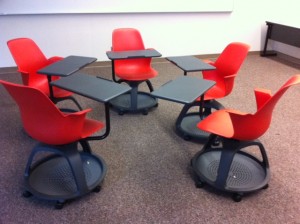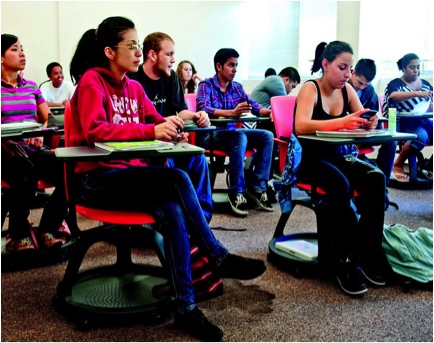
These "node chairs" are what’s new in classroom furniture. Their swivel seats, adjustable work surfaces and rolling bases adapt to match the lesson of the day, and highlight mobility and flexibility (photos by Robert Bain).
By Amanda Holst, Public Affairs Assistant
Wasabi, picasso and chili pepper red are some of the neon chair colors brightening general classrooms in Sweeney and Clark halls this fall.
These “node chairs” are what’s new in classroom furniture. Their swivel seats, adjustable work surfaces and rolling bases adapt to match the lesson of the day, and highlight mobility and flexibility.
“The manufacturer did exhaustive research on trends in the workplace, in schools and universities, and designed products that help users deal with their issues and to meet those needs,” said One Workplace Learning Environment Specialist Trevor Croghan.
One Workplace and SJSU worked together to develop a classroom that meets the needs of 21st century students and teachers, focusing on the ability to deliver and receive content in several different ways.
Node chairs allow users to easily reconfigure the classroom, from lecture-style, to small or large-group settings, to conference-style. Roomy storage space at the base of each chair, and arms designed to hold purses and backpacks, free the aisles of clutter. The chairs are able to accommodate right and light-handed students, and are comfortable for people of all sizes.
“With the traditional desks, many classmates refuse to crane their necks to look at the person speaking, making the class environment less than welcoming,” said nutrition major Miranda Westfall.
Mary McVey, interim associate dean in the Connie L. Lurie College of Education, an educational psychologist, sees other benefits.
“If students are sitting in a dynamic and engaged environment, they feel much better about coming back to class and are more likely to seek out information and learn outside the classroom,” McVey said.
The original idea to purchase the node chairs came in fall 2009, when the College of Education was working on creating the Leola Lyth Forward “Smart” Technology Classroom. A grant helped equip the smart classroom, including futuristic seating now in classrooms across campus.

